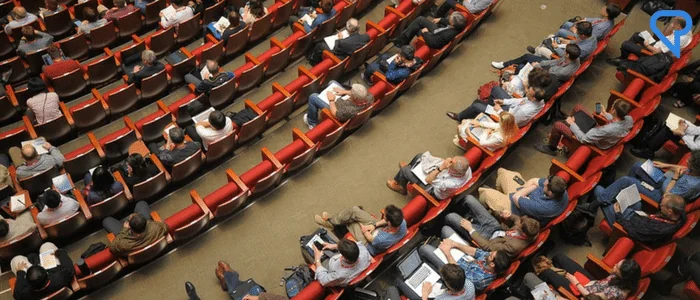I just returned from four wonderful days attending the 2018 Langfest (#Langfest18) or Montreal Language festival. While these memories are still fresh in my mind I want to put some of my thoughts down to share with you.
Overall impressions
Montreal is a vibrant city, and an old city for North America, or at least compared to Vancouver. Parts of the city, including the port area go back to the 1600s. Much of the city seems to consist of three or four story attached homes with their distinctive Montreal outdoor staircase up to the second or third floor. It was summer, of course, so Montrealers were very much out and about in their city. I could see them enjoying the warm weather on the little landings of their front staircase, in parks large and small, sitting in sidewalk cafés on streets like Saint Denis and Saint Laurent, riding on the subway, riding on the rent-a-bike system that is popular, or shopping and wandering aimlessly.
Montrealers come in all shapes, sizes and colors. Some are elegantly dressed and some are not so elegantly dressed. At least in downtown Montreal they are remarkably bilingual. You never know if the person you are talking to is an Anglophone or a Francophone. Other languages are also heard on the streets. Everybody seems to get along well.
Montreal is an easy city to get around in. I bought a three day transit pass and then followed that up with a weekend pass. The metro system was very convenient for wherever I wanted to get to. The transit pass also worked on the buses, although you move a lot more slowly above ground than underground, unless you are walking or on a bicycle.

Attendees
Who attends these language festivals? Most of the attendees were Canadian, 60% or so. 30% were from the United States, much more than previous years, which, for me as part of the organizing group, is very encouraging. There were attendees from Central America, Europe, and even one from Egypt.
Most people attending the conference are interested in languages, of course, and speak a few. It appears that other than English, French, Spanish, German and Mandarin Chinese were the most widely spoken language among attendees,mostly as second languages. Many attendees are able to speak multiple languages, four, five, six or more. Quite a few people speak more than 10 languages. But there are also people who only speak two languages.
There is an inherent atmosphere of goodwill and mutual support regardless of how many languages people speak. It’s as if this common interest in languages creates a bond of friendship between people who have never met each other before, although many people are in touch via social media. It’s a wonderful feeling to be amongst people who are inclined to want to be your friend simply because you are together with them and share an interest. Anyone can approach anyone else and strike up a conversation. There is no rejection or snubbing. This atmosphere of only positive vibes is one of the main reasons why these conferences are so enjoyable.
Themes
A visit to the website can give you an indication of the kinds of subjects that were discussed in the program. To some extent the themes are common with subjects that are discussed at other similar gatherings such as the Polyglot Conference and the Polyglot Gathering, both of which take place in Europe.
To summarize, the discussions seem to be either about language learning techniques, language learning resources and tools, some aspect of new languages, endangered languages, or the politics of language. In other words anything you might think of that had to do with language was discussed and debated amongst this friendly group of language enthusiasts.
Usually there are three presentations going on simultaneously. This means that one often has to choose between two or more talks, both of which we would be interested in hearing. The number of attendees vary from smaller groups of 20 or 30 people to larger audiences of several hundred. Most of the presentations were excellent and generated questions and lively discussion with the audience.
Going forward
As I reflect on the conference, I am left with the feeling that most people, including the participants, see these kinds of get-togethers as something just for high performing polyglots, people who speak many languages. Sometimes such people are perceived as having special talents or special brains. That is the impression created by articles such as this recent article in the New Yorker entitled “The Mystery of People who Speak Dozens of Languages”.
There was a participant at the conference who said to me “ you people who speak many languages have something different in your brain.“ I thought to myself, perhaps these conferences tend to reinforce that concept and discourage average language learners from attending. The number of people who would like to, or need to, learn even one foreign language is huge, numbering in the billions. Perhaps the polyglot conferences are too focussed on the interests of a very small group of people, those who realize that it’s no big deal to learn many languages. Perhaps more needs to be done to reach out to the average language learner.
One of the interesting presentations at Langfest was a group brainstorming session on on the resources, tools and activities available to language learners today. The audience was split into small groups and was asked to come up with the most useful resources, tools and activities that they knew of.
I used to say that language learning success depended on the attitude of the learner, the time spent with the language, and the ability to notice. I have changed my mind. I think the ability to notice is something that naturally develops if we have a positive attitude and spend enough time with the language. The third crucial element to language learning success is the availability of comprehensible and compelling content, audio with transcript. Those languages that I have learned well and quickly are those languages for which I was able to find interesting content at different levels of difficulty .
This makes me think that what is needed in future language conferences is a greater focus on these three subjects. Perhaps our brainstorming session on resources, tools, and activities could be expanded into a full blown conference.
Speakers would be invited to present on:
a) Content.
Presenters could be publishers of language learning material, online bloggers and teachers, or simply volunteers who are willing to record and transcribe conversations or monologues or other material in their native language and share these or exchange these with other people who might be willing to do the same. Learners could also talk about how they go about finding and managing compelling and comprehensible content for the languages they are learning. This information would be shared, and perhaps some content generation projects might come out of this.
b) Tools.
Creators and users of popular or even lesser known apps, tools, books, and language learning websites could provide demonstrations. There could be discussion of the kinds of tools that are needed. This could be valuable for learners, teachers and developers.
c) Activities.
Obviously there is some overlap with content and tools. Presenters could talk about how they learn, which activities they find most effective. This could lead to lively discussion and even debate. This could be valuable to experienced learners as well as people who would like to learn but don’t know where to start.
Perhaps a conference focused on these subjects might help persuade more people that language learning is normal, and even learning multiple languages is something that we are all capable of doing if we are sufficiently motivated especially if we become aware of the wealth of resources available that make language learning easier today than ever before.









1 comments on “Thoughts on Langfest 2018 and Future Recommendations”
Comments are closed.
Hello, love to read your article and get so much information through your blog and learn new things. You write very well, am amazed by your blogging, you will definitely achieve success.